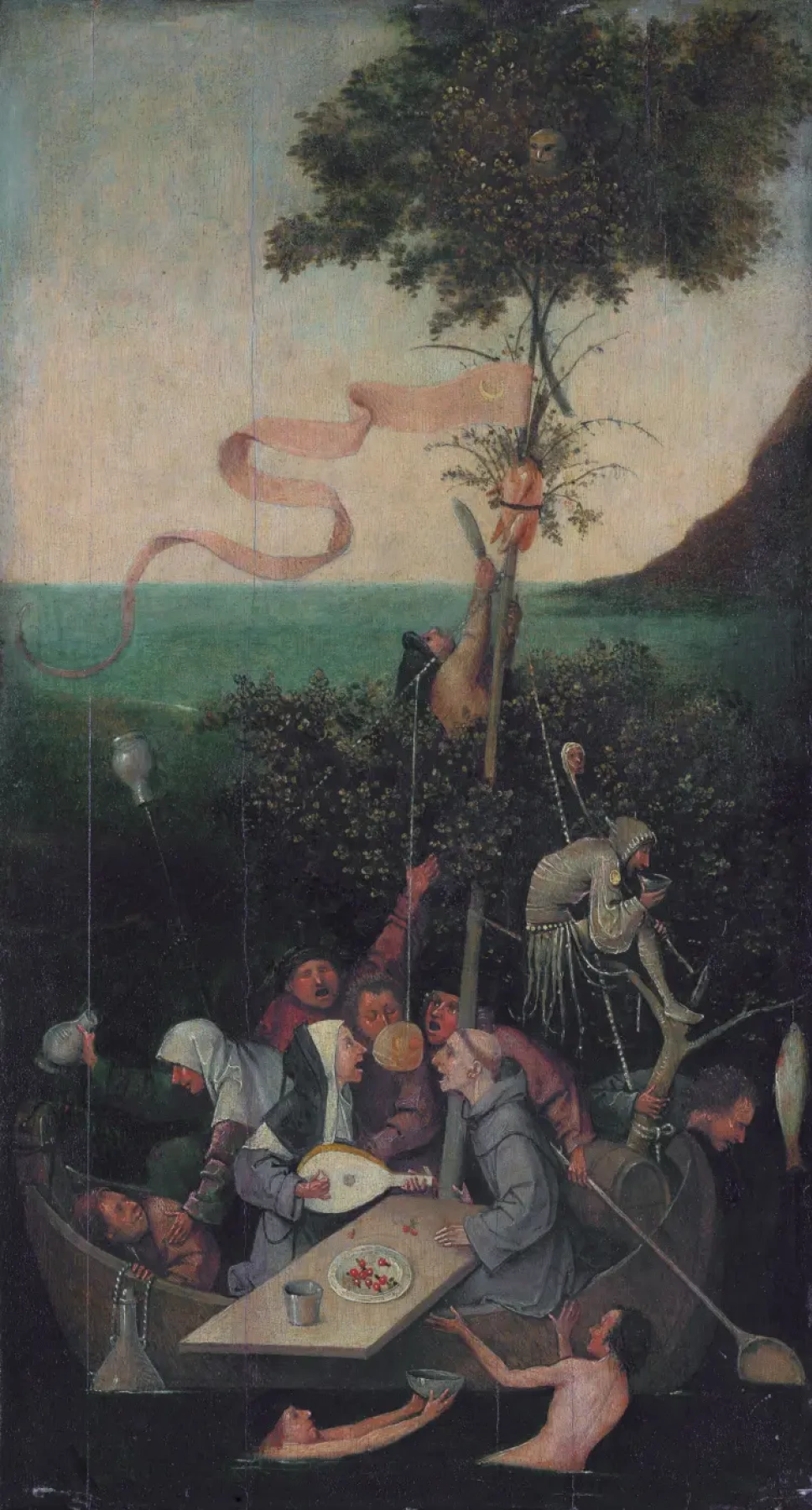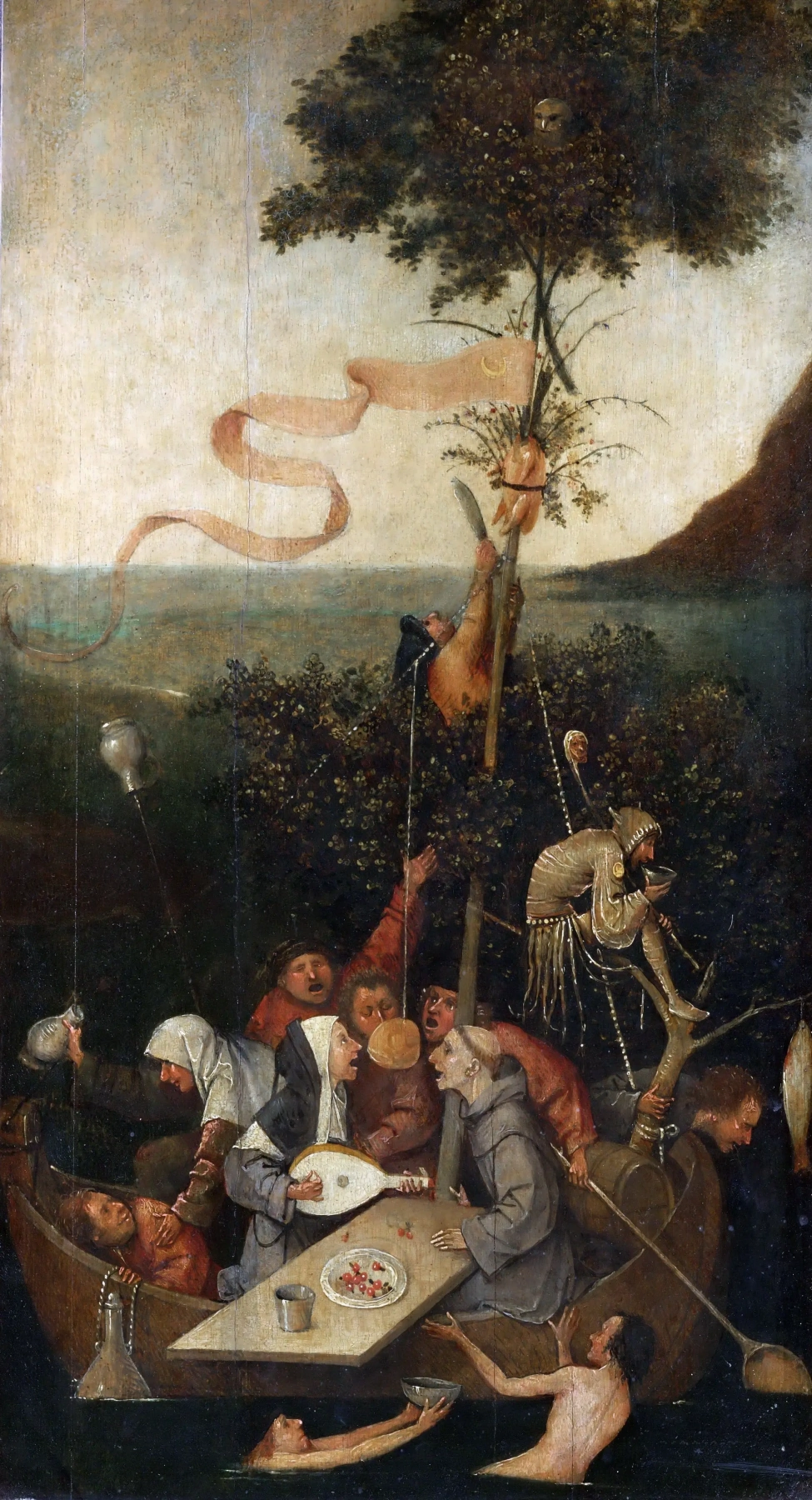log in
Enter site
Login to use Arthive functionality to the maximum
Ship of fools
Hieronymus Bosch • Pittura, 1490-mo
, 57.8×32.5 cm


















Descrizione del quadro «Ship of fools»
The idea that "Ship of fools"from the Louvre – not a single work, but rather, part the lost triptych expressed sufficiently long time. But only in the beginning of 2016 years, while exhibition of Bosch in his homeland in the Dutch city of ' s-Hertogenbosch, the pieces managed to gather under one roof. The Central part of the intended triptych is considered to be gone, but his wings are the famous paintings of Hieronymus Bosch: the right is "Death of a miser" (National gallery, Washington), left the sash is formed from two now-separated work – "Allegory of gluttony and lust" (Art gallery of Yale University) and "Ship of fools" (Louvre, Paris).
However, for several centuries the "independent sailing" deposited in the Louvre the Harbor "Ship of fools" of Hieronymus Bosch, was perceived and interpreted as a completely independent work.
Characters
On a small fragile boat was going to close the company. A dozen people occupied a variety of things: they sing, drink, get water, stretch gaping mouths hanging over a loaf of bread, and someone most decisive – climbs the mast with a knife in hand to cut someone unknown hung in there fried bird. Two of them (monks and nuns) and clergy, and the rest wore dresses of the commoners. And without exception, look to put it mildly, not very comely.
"Yes, and their faces are funny– says about the inhabitants of the "Ship of fools" art historian Paola Volkova. – They are not persons – they are the characters of the farcical action. They all look the same, all the characters are the same. The impression is that they all have Bosch come out with a conveyor. Uncles and aunties – to distinguish them from each other at Bosch is very difficult, except for clothes. They are planed wooden men. Semi people. They only have the symptoms of a person: head, hands, eyes. Bosch has opened a completely new hero. Wrote a children's poet, "to each other all alike, all with tails on the side". It's not even people – is the weight of a human, who lives by instinct, some sort of primary life.
Ship
Well, portraying these people, seeks to convey a Bosch? For this you need to answer that symbolizes the ship. First, the ship is an allegory of human life, when viewed as a risky voyage. Secondly, in the medieval aesthetic of the ship is uniquely associated with the Church. The Central part of the temple was called "the nave" – that is, the ship (the French word nef comes from the Latin navis – the ship). The Church was seen as a vehicle of salvation, the only way to stay afloat in the turbulent waters of existence.
But the ship from Bosch, it seems, a long time will not swim. It sits stranded in the murky waters of the dark shore, and its mast already sprouted and turned into a tree. Why is this happening? Why the ship of salvation is not able anyone be saved? Obviously, human vices, although not yet dragged the ship to the bottom, but do not allow him to move forward. A monk and a nun singing to the music of the merry song – like music in painting of the era was interpreted as a prelude to lovemaking. At this point, lying on the table cherry – the symbol of voluptuousness. All the others seem preoccupied with thoughts of food and drink, and they do not care about the meaning of life or salvation. Because on top of the "Ship of fools" looks not to Christ (as in the triptych "The hay"), not a Wife, "clothed with the sun" (as in "John on Patmos") and Christmas star (as in "The adoration of the Magi), and hiding in the tree the owl is the bird of the night and a symbol of the devil.
About the meaning of the name
We do not know what names were given to their paintings of Bosch: all of them owe their names to the directories. Most likely, the painting was named "Ship of fools" later, by analogy with the eponymous poem of a contemporary Bosch Sebastian Brant. In their skeptical views on modernity they are Bosch largely coincided. "In the darkness of night and the world is submerged, rejected by God, / the Fools swarming on all roads"– wrote Brant. Stupidity and for the poet and the artist is the root of many evils. To collect the "dark people" to the ship and send everyone EN masse to the country Gulangyu – such a solution was offered of Brant. But I think the characters of Bosch to this destination didn't: left to eke out their unenviable existence on the ship, which instead of moving forward, took roots at the shore.
The image of the jester
Some interpreters believe that the "Ship of fools" of Hieronymus Bosch, there are the author's intonation, the author's voice. It is embodied in the image of the jester is a hunchback who sits with a Cup of wine, turning away from everyone. The jester is the only one of the inhabitants of the vehicle, who is not embroiled in the General sinful fun, the only one who apparently realizes that it all went wrong.
Technical details
In preparation for the work Bosch did a lot of sketches on paper, then to transfer the most successful variant on a wooden panel.
The layer of paint in "Ship of fools" is so thin that in many places you can see the lines of the preliminary drawing. Work has been subjected to multiple unsuccessful attempts of restoration (the first was made during the life of the Bosch), and it's certainly not the best way affected its present state.
Author: Anna Yesterday
However, for several centuries the "independent sailing" deposited in the Louvre the Harbor "Ship of fools" of Hieronymus Bosch, was perceived and interpreted as a completely independent work.
Characters
On a small fragile boat was going to close the company. A dozen people occupied a variety of things: they sing, drink, get water, stretch gaping mouths hanging over a loaf of bread, and someone most decisive – climbs the mast with a knife in hand to cut someone unknown hung in there fried bird. Two of them (monks and nuns) and clergy, and the rest wore dresses of the commoners. And without exception, look to put it mildly, not very comely.
"Yes, and their faces are funny– says about the inhabitants of the "Ship of fools" art historian Paola Volkova. – They are not persons – they are the characters of the farcical action. They all look the same, all the characters are the same. The impression is that they all have Bosch come out with a conveyor. Uncles and aunties – to distinguish them from each other at Bosch is very difficult, except for clothes. They are planed wooden men. Semi people. They only have the symptoms of a person: head, hands, eyes. Bosch has opened a completely new hero. Wrote a children's poet, "to each other all alike, all with tails on the side". It's not even people – is the weight of a human, who lives by instinct, some sort of primary life.
Ship
Well, portraying these people, seeks to convey a Bosch? For this you need to answer that symbolizes the ship. First, the ship is an allegory of human life, when viewed as a risky voyage. Secondly, in the medieval aesthetic of the ship is uniquely associated with the Church. The Central part of the temple was called "the nave" – that is, the ship (the French word nef comes from the Latin navis – the ship). The Church was seen as a vehicle of salvation, the only way to stay afloat in the turbulent waters of existence.
But the ship from Bosch, it seems, a long time will not swim. It sits stranded in the murky waters of the dark shore, and its mast already sprouted and turned into a tree. Why is this happening? Why the ship of salvation is not able anyone be saved? Obviously, human vices, although not yet dragged the ship to the bottom, but do not allow him to move forward. A monk and a nun singing to the music of the merry song – like music in painting of the era was interpreted as a prelude to lovemaking. At this point, lying on the table cherry – the symbol of voluptuousness. All the others seem preoccupied with thoughts of food and drink, and they do not care about the meaning of life or salvation. Because on top of the "Ship of fools" looks not to Christ (as in the triptych "The hay"), not a Wife, "clothed with the sun" (as in "John on Patmos") and Christmas star (as in "The adoration of the Magi), and hiding in the tree the owl is the bird of the night and a symbol of the devil.
About the meaning of the name
We do not know what names were given to their paintings of Bosch: all of them owe their names to the directories. Most likely, the painting was named "Ship of fools" later, by analogy with the eponymous poem of a contemporary Bosch Sebastian Brant. In their skeptical views on modernity they are Bosch largely coincided. "In the darkness of night and the world is submerged, rejected by God, / the Fools swarming on all roads"– wrote Brant. Stupidity and for the poet and the artist is the root of many evils. To collect the "dark people" to the ship and send everyone EN masse to the country Gulangyu – such a solution was offered of Brant. But I think the characters of Bosch to this destination didn't: left to eke out their unenviable existence on the ship, which instead of moving forward, took roots at the shore.
The image of the jester
Some interpreters believe that the "Ship of fools" of Hieronymus Bosch, there are the author's intonation, the author's voice. It is embodied in the image of the jester is a hunchback who sits with a Cup of wine, turning away from everyone. The jester is the only one of the inhabitants of the vehicle, who is not embroiled in the General sinful fun, the only one who apparently realizes that it all went wrong.
Technical details
In preparation for the work Bosch did a lot of sketches on paper, then to transfer the most successful variant on a wooden panel.
The layer of paint in "Ship of fools" is so thin that in many places you can see the lines of the preliminary drawing. Work has been subjected to multiple unsuccessful attempts of restoration (the first was made during the life of the Bosch), and it's certainly not the best way affected its present state.
Author: Anna Yesterday



